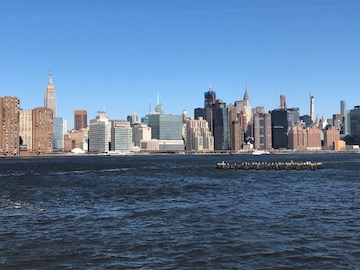
Hi all. We arrived back recently from NYC and had a good time, seeing many neat sights. The one at left is taken from Brooklyn after we disembarked the ferry and looked back to Manhattan. We had some sunny days and snow too, but the temps in the 30s were all pretty easy to us Canadians. We stayed in the Midtown area and got around everywhere by subway and walking, which worked out well. Apparently, our hotel, the Barclay, was where Ernest Hemingway worked on the final revisions of his novel “For Whom the Bell Tolls” after he returned from Spain with his fiancee and fellow war correspondent Martha Gellhorn. The book rests proudly on display in the lobby. I just thought you might like that literary tidbit. Poor Gellhorn and Papa, their love didn’t work out quite as well.
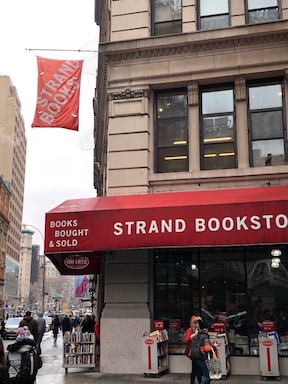
Besides Brooklyn, we visited Central Park, and toured the Guggenheim Museum, and the 9/11 Memorial & Museum, which is quite gut-wrenching. We saw a Sam Shepard play on Broadway called “True West,” starring Paul Dano and Ethan Hawke, which we didn’t really love, but still it was a thrill to see close-up.
And of course we visited a couple of bookstores, including the Strand and a rare bookstore called Argosy. Little did I know that I would see that same bookstore featured in the movie “Can You Ever Forgive Me?” on the flight home, but there it was the same one we visited. Apparently the real Lee Israel, who the character is based on, stole some letters that she sold to Argosy bookstore so she could pay her cat’s vet bill. It’s a true story that became part of the movie.
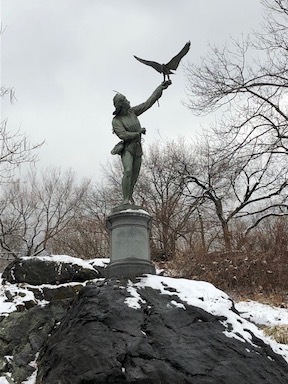
Anyways what also was terrific was making a trek to find “The Falconer” statue, which we knew was somewhere within Central Park. It was the name of Dana Czapnik’s debut, coming-of-age novel that I was reading and had brought with me on the trip — about a smart 17-year-old girl who lives for basketball and is in her final year of high school in New York City, circa 1993. More on the book in a minute, but I was on a quest to find the statue.
My husband had a map and after a bunch of walking we had “The Falconer” in our sights (see my photo at left). As the novel notes: it’s a statue of a young boy in tights with muscular legs, releasing a bird, the falcon’s wings in the midst of opening. The character in the book, Lucy Adler, says she’s always loved it for the skyward feeling it embodies like a perfect jump-shot, and she’s envious that there are statues like this made of boys but none of girls. “Why,” Lucy muses, “can’t girls with muscular legs in leggings stand on a hilltop and release a bird?”
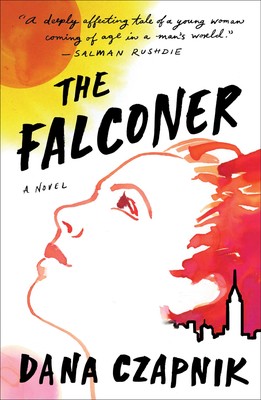
It’s a fitting symbol for this coming-of-age novel, told in the first person. Lucy is athletic and soon to graduate, she’s trying to figure out her plans — whether she will leave her beloved city and where she stands in her young life. She’s in love with her basketball buddy Percy, who seems oblivious to her feelings despite hanging out with her everyday. Lucy silently agonizes as Percy goes through a string of girlfriends. When she’s not with him, she reflects on her feelings and the city, while meandering around Manhattan with her basketball teammate Alexis and meeting up often with two female artist friends in SoHo, who advise her about life, love, and art.
For the most part, I enjoyed this novel. I was particularly impressed by how well the author captures the few basketball playing scenes in the book. Lucy’s a great player and those were among my favorite parts of the book — of her playing pick-up games and with her high school team, along with the details about New York and the parts with Percy. I kept hoping she and Percy would get together, but you don’t find out till the end whether they do, or which direction Lucy and Percy will go in after graduation. I liked spending time with Lucy. She’s a smart girl, who learns a bit about herself, life, and feminism along the way.
My only hesitancy about the novel was at times it felt rather plotless as Lucy wanders around the city, meeting up with people, a couple of whom (like the two artists) didn’t really hold my interest. I kept wanting to get back to the main story about her and Percy and whether she could handle or grow from this stage in her life. Despite these reservations, I thought much of the writing about Lucy was quite beautiful and well done. Some reviewers even speculated Lucy could be compared to such New York protagonists as Francie in “A Tree Grows in Brooklyn” or Holden in “The Catcher in the Rye.” To me, that seems a bit of a stretch, but still it’s a novel in that kind of genre.
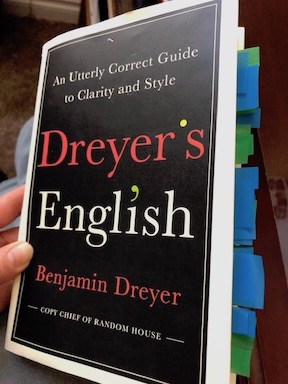
Next up, I read a book I bought at the Strand bookstore called: “Dreyer’s English: An Utterly Correct Guide to Clarity and Style” by Benjamin Dreyer. I know it sounds dry (especially since I was reading it on the flight back), but I’m one of those types that will read grammar and usage manuals every time a new notable one comes out. The last one I read was Mary Norris’s 2016 book “Between You & Me: Confessions of a Comma Queen,” which was great, about the author’s years on the copy desk at The New Yorker. Like that one, this new book is a little part memoir and also a reference manual on grammar and style usage by a veteran editor who happens to be the copy chief at Random House. I had heard about his new book when it was featured on the New York Times book podcast recently.
As a former newspaper copy editor, I knew “Dreyer’s English” would be right up my alley and indeed it was. Even though the author describes many of the same rules about punctuation, grammar, and style that I’m already familiar with, I’m always keen to brush up on knowing them, or finding out if there’s anything new to learn (see all my sticky notes in the book photo). Apparently this author meandered into his profession nearly three decades ago, learning it on the job over the years as he observed copyediting, how it was done and how writers responded to it.
Dreyer takes a refreshing, often witty look at old rules and which ones can be broken and which can not. He has chapters on Tidying Up Your Prose and 67 Assorted Things to Do (and Not to Do) with Punctuation, and the treatment of numbers and foreign words. There’s lists on commonly misspelled proper nouns, and lists of words that are often confused, such as: imply vs. infer, discreet vs. discrete, and hanged vs. hung, etc. He has a chapter on his language pet peeves that includes commonly misused words and redundant words strung together that can be deleted. He has a few cool anecdotes about authors he’s edited and their language quirks, though I wish there would have been more of these throughout the book.
I pretty much agreed with most of the style/grammar rules he writes about, including his firm belief in using the serial comma on items in a list, such as: apples, oranges, and bananas. Though I thought his style on numbers a bit too loosey-goosey compared to how they are done in newspapers, which are spelled out up to nine and written as numerals thereafter. In book publishing numbers are mostly spelled out but are also seen as numerals in various cases. Hmpf, there seems less of a system there.
The author also adds many tiny footnotes at the bottom of each page in the book, which was not my cup of tea. I’d rather he had added them into the text so I could have noted what he wanted to say much more easily. Despite these reservations, I thought the book was a helpful, witty, and solid guide that goes into many of the pesky particulars on everything from apostrophes to dashes to semicolons to dangling modifiers, and beyond. If you want to brush up on your writing, definitely check it out.
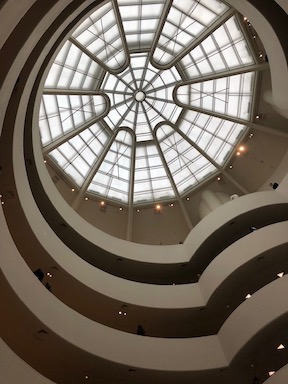
PS. This blog is meant to be casual when it comes to writing style and punctuation. I’m sure I’ve made various grammar mistakes over the years here, though I try not to. One thing you might wonder is why I put book and movie titles in quotation marks instead of in italics like the rest of the publishing world. It’s because in newspapers, where I worked, they were always placed in quotation marks, which was drummed into my skull. That’s just one of a number of differences you’ll see between the print in publishing vs. in journalism. Someday I figure I’ll be due for a change on this.
That’s all for now, what about you — have you read either of these, and if so, what did you think? Or what’s your favorite place in New York? Maybe it’s the Guggenheim Museum that’s pictured above.

Your trip to The City sounds like so much fun! As many times as I’ve been there, I’ve never been to The Strand.
Both books sound good to me although I would probably read the second one in short spurts.
Thanks Kathy. Yeah I know you go to NYC for BookExpo so you must know it well. I hope to go to it next year. It is a lot of fun visiting there.
I for one have never noticed any grammatical errors and wouldn’t care if I did!
Your trip sounds like so much fun, and what a treat to find The Falconer statue just as you were reading the book. I really liked Lucy’s story and was okay with it moving away from Percy. (The cad!)
In New York I adore spending a day or two at the Met and I also like MOMA. I took a lot of art appreciation classes in college and can get lost in museums for hours. I actually prefer going to them by myself so I can spend as much or as little time as I’d like with a painting or sculpture. I also always like to see a play or two and usually do musicals. It’s such a fun, frantic place.
Thanks for your comments Susie. Yeah it was great to be reading The Falconer novel right as I was in NYC, wow. I guess you’re right about Percy, he was a cad though I kept wishing that he’d wise up to how great Lucy was — but he didn’t wise up enough! I’d like to get to the Met and MoMa, maybe next time. I was surprised I enjoyed the city so much — I’m not a big city person but it was really was neat. You seem to know it pretty well.
It sounds and looks like you had a great trip. I love New York City Bookstores, especially The Strand.
I must admit that the Dreyer book sounds interesting. That seems a little bit of an odd thing to write about a work dedicated to grammar. However, I tend to like odd and obscure rules. We Bloggers obviously write so it would probably be useful.
Hi Brian, do you get into the City much? The bookstores are very cool there. I hope to return, maybe next year. The Dreyer book has a lot of little tidbits on words and grammar that we don’t often think about but are useful to know. I found it a helpful guide and I’d think you’d like it for that.
I proclaim this as one of your best posts ever, at least for as long as I have been reading them. It read like an exciting novel! You made me so nostalgic for NYC. Both books sound good to me. Now that I am writing again I could use some of that advice in Dreyer’s book.
BTW, I recently acquired Patty Griffin’s new album (title: “Patty Griffin”) and am loving it. I don’t know if you are a fan.
Wow Judy thanks. That means so much coming from you. I’m glad, I try to make my posts at least interesting. Our trip to NYC really surprised me that I liked it so much, ha. I’m not a big city person but thought it had so much to offer, duh! I liked Dreyer’s book or there’s always the Chicago Manual of Style which is a bit unwieldy. Dreyer mentions a reference book called Words Into Type that he likes. I haven’t tried that one. I just bought the new Patty Griffin album based on your comment. I have liked her music in the past. Thanks for the reminder about it. I’m going to like it.
I love the story about the statue. Sounds like you had a great trip and managed to see lots of places while there. The Strand! I would never leave.
I was NY born but only lived there until age three. I remember the Subway and the park and of course, the zoo. I visited just once when I was ten but haven’t been since.
Hey, the Booker long list was announced but I only recognize one book on it!
Hi Ti, I didn’t realize you were NY born. I think you deserve a trip back. You would like The Strand … and you would never leave, ha. Thx for telling me about the Booker. It appears its the International Prize for translated works (Booker) … and not the regular Booker Prize for English written novels, so that is likely why you don’t recognize the names. Not to worry. They offer both prizes each year. I must admit I should read more translated works though I have trouble staying afloat with the English novels.
How exciting! You visited places in NYC I’ve never been to, like the 9/11 Memorial, the Bookstores, and Central Park. I’ve visited the Empire State (twice), the Statue of Liberty, the Met, Ripley’s and Madam Tussaud’s Museums, I’ve been on a guided tour about the city and the islands, and I look forwards to many more visits, but I confess the 9/11 Memorial would be too much for me. I had a hard time coping, back when all that happened.
Anyways, how cool that you visited the same bookstore that Lee Israel scammed. 😉 Did you like the movie? It’s also a cool coincidence that you got to see The Falconer statue as you were reading (and enjoying) the novel it is mentioned in. You made nice memories, and now you can always associate the movie and the book with NYC. 🙂
Hey Carmen, thanks for your nice comments! NYC really surprised me; I didn’t expect to like it as much as I did, but it was all quite easy to maneuver and a lot we got to see. We were there like 6 days so we did try something new each day. You’ve seen a lot there too. We took some photos of the Statue of Liberty from the Staten Island ferry but did not go there. I about lost my cookies at the 9/11 Memorial Museum tour, so beware it is intense in places. The bookstore & the Falconer are neat memories, yeah fun. But if you can believe it: the Lee Israel movie ended before the flight so I have to see it again, but I liked it!
BTW, Susan, check your comments folder (spam included), for some I have submitted and are not shown–someone is wrecking havoc with my comments system.
Thanks for telling me about this Carmen. I’m really sorry about this. I have checked and haven’t found any more comments so far, even in the Spam folder. I will keep looking to see if I can find out what happened. I didn’t realize you had sent anymore. crimminy. I hope my system is not on the fritz. I will let you know if I find them.
Your trip to NYC sounds wonderful! We were there at Christmastime and I’m already looking forward to another visit this summer. My daughter’s reading is mirroring yours. She recently loved The Falconer and saw the author at an event at Book Culture on the Upper West Side. Dreyer’s English is near the top of her tbr. I hope to get to that one soon, too.
Hi JoAnn: thx for the note. Wow NYC was fun, who knew? It’s funny how many books your daughter & I seem to share. We have good tastes! Was she born under the Virgo sign? Glad she liked The Falconer and has Dreyer’s English in her sights. I’m just finishing the audio of Mrs. Obama’s book and I think she has read that one as well. Excellent.
I envy your trip to NYC…and can imagine walking those streets, although I’ve only read books or seen movies set in Manhattan.
Your mention of Ernest Hemingway and Martha Gellhorn reminded me that I have a Meg Waite Clayton book about them: Beautiful Exiles. I need to read it! I saw a movie about them, too…on Prime.
Enjoy your week, and thanks for visiting my blog.
Thanks Laurel: I’d like to see the Hemingway and Gelhorn movie. I’ll look for it on Prime. I did enjoy the Paula McLain book on them. The NYC trip went much better than I expected and I might even consider a trip there next year.
Sounds like a terrific trip to NYC. I haven’t seen the statue of the Falconer on any of my trips to the city (we always go to Central Park), so I’ll be looking for it next time.
Yeah Jane, it was a great trip. We had to go searching for the statue. My husband had a map of all of the statues in Central Park so we were able to find it. You can get it perhaps on your phone while you’re walking there. I might even go back next year. Hmm.